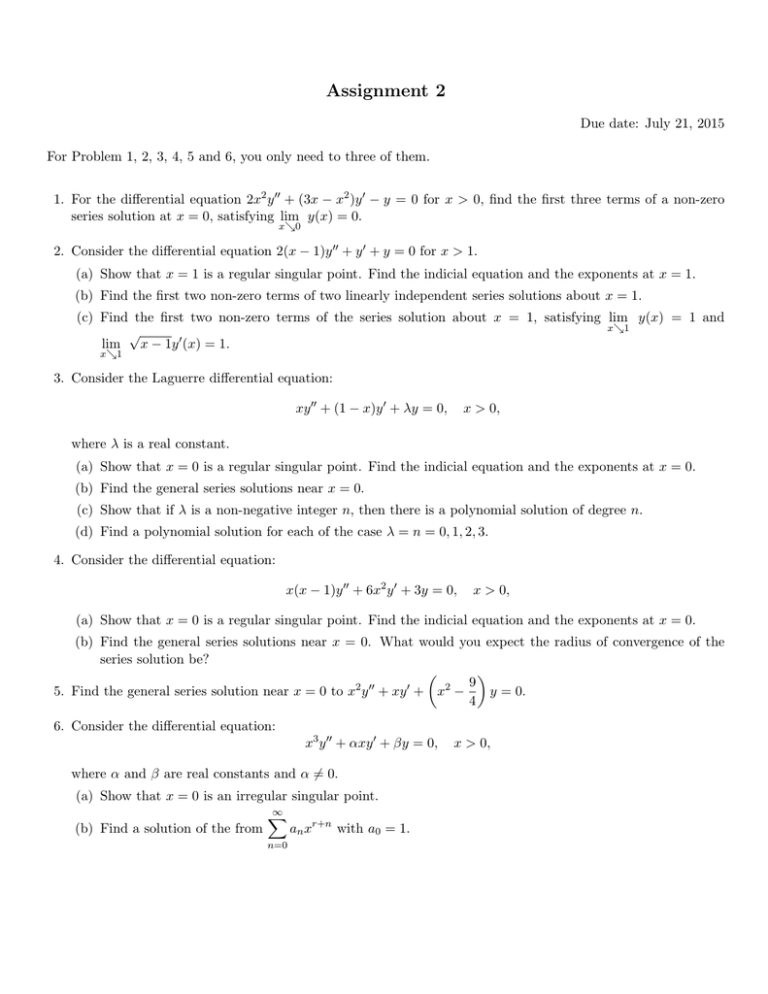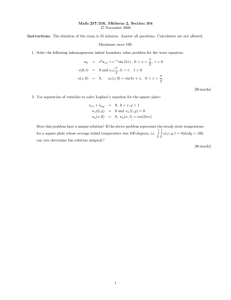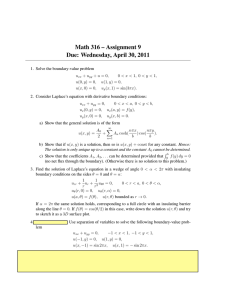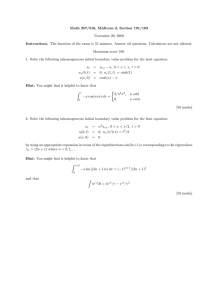Assignment 2
advertisement

Assignment 2 Due date: July 21, 2015 For Problem 1, 2, 3, 4, 5 and 6, you only need to three of them. 1. For the differential equation 2x2 y 00 + (3x − x2 )y 0 − y = 0 for x > 0, find the first three terms of a non-zero series solution at x = 0, satisfying lim y(x) = 0. x&0 2. Consider the differential equation 2(x − 1)y 00 + y 0 + y = 0 for x > 1. (a) Show that x = 1 is a regular singular point. Find the indicial equation and the exponents at x = 1. (b) Find the first two non-zero terms of two linearly independent series solutions about x = 1. (c) Find the first two non-zero terms of the series solution about x = 1, satisfying lim y(x) = 1 and x&1 √ lim x − 1y 0 (x) = 1. x&1 3. Consider the Laguerre differential equation: xy 00 + (1 − x)y 0 + λy = 0, x > 0, where λ is a real constant. (a) Show that x = 0 is a regular singular point. Find the indicial equation and the exponents at x = 0. (b) Find the general series solutions near x = 0. (c) Show that if λ is a non-negative integer n, then there is a polynomial solution of degree n. (d) Find a polynomial solution for each of the case λ = n = 0, 1, 2, 3. 4. Consider the differential equation: x(x − 1)y 00 + 6x2 y 0 + 3y = 0, x > 0, (a) Show that x = 0 is a regular singular point. Find the indicial equation and the exponents at x = 0. (b) Find the general series solutions near x = 0. What would you expect the radius of convergence of the series solution be? 9 2 00 0 2 5. Find the general series solution near x = 0 to x y + xy + x − y = 0. 4 6. Consider the differential equation: x3 y 00 + αxy 0 + βy = 0, where α and β are real constants and α 6= 0. (a) Show that x = 0 is an irregular singular point. ∞ X (b) Find a solution of the from an xr+n with a0 = 1. n=0 x > 0, 7. Solve the transport equation with the initial condition: ut + 3ux = 0, x ∈ R, t > 0. u(x, 0) = cos(x), x ∈ R. 8. Solve the transport equation with the initial condition: ut + 2ux = ex+t , x ∈ R, t > 0. u(x, 0) = sin(x), x ∈ R. 9. Determine whether the method of separation of variables can be used to replace the given PDEs by a pair of ordinary differential equation. If so, find the equations. (a) xuxx + ut = 0. (b) uxx + uxt + ut = 0. (c) uxx + (x + y)uyy = 0. (d) [p(x)ux ]x − r(x)utt = 0. (e) uxx + uyy + xu = 0. 10. Solve y 00 + y = 0, y(0) = 0 and y 0 (π) = 1 if the solution exists. 11. Solve y 00 + y = 0, y 0 (0) = 1 and y(π) = 0 if the solution exists. 12. Use separation of variables to find PDE: BC: IC: 13. Use separation of variables PDE: BC: IC: the solution to the heat conduction problem: 100uxx = ut , 0 < x < 1, t > 0, u(0, t) = 0, u(1, t) = 0, t > 0, u(x, 0) = sin(2πx) − sin(5πx), 0 ≤ x ≤ 1. to find the solution to the heat conduction problem: uxx = 4ut + u, 0 < x < 2, t > 0, u(0, t) = 0, u(2, t) = 0, t > 0, πx − sin(πx) + 4 sin(2πx), u(x, 0) = 2 sin 2 Page 2 0 ≤ x ≤ 2.




